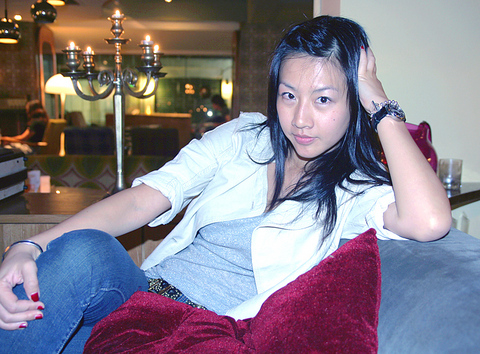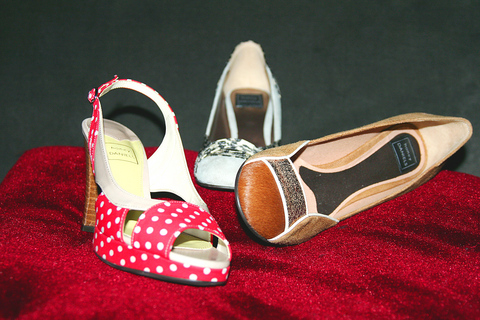She makes the shoes that pop and movie stars like Jolin Tsai (蔡依林) and Vivian Hsu (徐若瑄) step out in. But Chloe Chen is heading west rather than east to expand her small fashion realm.
The director of Omni — a retro furniture and style store run in collaboration with Taiwan's chairman of pop Jay Chou (周杰倫) — Chen also heads up Honey Daniels shoes.
She has opened two outlets in the fashionable East District and Xinyi District, where her shoes sell for around NT$3,000 to NT$6,000.

PHOTOS: JULES QUARTLY, TAIPEI TIMES
And if the name Honey Daniels gives you deja vous it's because the company is named after the feel-good movie starring Jessica Alba, as a dancer who makes it in New York.
Chen says her current dilemma is whether to ship shoes to the US and compete with brands like Manolo Blahnik, or manufacture cheaper products at factories in China and take on the mass market.
As much as Chen is a designer of shoes she's also a pretty experienced 30-year-old businesswoman. Her philosophy is: “If it's a good product, it should sell.”

“Our pricing is kind of high, so our segment of the market is quite narrow. We've come to a point where there's no growth. So, either we sell just to stars and rich people, or we reduce our costs and go to China.”
The fact she recently attended an English-language school in the US indicates she has already made her decision.
“We would rather look at other markets and take our shoes to places like New York where prices are relatively expensive. For instance, Manolo Blahnik are not that well made. They just have great marketing. Sex and the City tripled their price.”
Chen says of a visit last week to the Big Apple that she went to the store Barneys and had a chance encounter with Gwyneth Paltrow's agent, who expressed an interest in her shoes.
Though Chen designs and has what one of her China-based agents calls “great taste,” she's also adept at marketing. She majored in advertising at Chinese Culture University in Taipei.
“Studying advertising gave me a lot of background, it was a major influence. If I had only studied arts I don't think I would have done this. I thought advertising was creative but actually it turned out to be business,” Chen says.
Her first job was gopher at an advertising firm, but she realized it wasn't her. Her businessman father said, “Follow your dreams” and instead of going to the office she opened her first shop in Tienmu, Taipei. She mainly imported Hong Kong fashion and it was a big hit.
While her father backed her financially, Chen credits her mother with inculcating a sense of fashion, nurtured by what she speaks of as a fairly idyllic childhood in Taitung.
“At school I was a fashion leader, a trend setter rather than a sheep. At university there was a nearby flea market run by foreigners with second-hand clothing and furniture, a lot of good stuff at reasonable prices. I used it and altered it to make it stylish.”
“I always buy what I like and I thought if couldn't sell the clothes then I could wear them myself. That's why I only bought a few items of a kind — in case they did not sell.”
“We were different from other stores. We picked a second-floor location because we did not want walk-in traffic. We wanted it to be special, alternative. I put up a big heart with our name and painted the window. We bought an old fridge and cleaned it out, using it for display. There wasn't a set formula.”
She opened a second store in an apartment with Hong Kong designer Toby Liu, who now works for D-Mop.
“I started to get frustrated because I couldn't find the clothes I wanted, so we co-operated in making clothes. We made what I wanted.”
But after two years she closed this store because its costs were too high for the market. It was her first and so far only failure.
“I realized it was easier to buy stuff than make myself. Also, I learned a lesson about marketing and selling. You have to think harder before you start something. You have to prepare well.”
So she moved to Taipei's East district five years ago and did it with a splash of publicity by starting Omni (“all things”) with Chairman Chou, who's into retro fashion, furniture and classic cars.
“When I was young I liked antiques and clothes and mother's shoes, but her feet were so small I couldn't wear them. I went abroad to find vintage shoes because customers wanted them. I realized shoes were the most important part of clothing.”
Chen decided to found her own label and her dad found a manufacturer of hand-made shoes in South Korea. She has her shoes made from drawn designs.
She designs the shoe, picks the materials and then works with the manufacturer to make a sample.
“I do not have formal training, that's why I'm different and successful. Comfort is very important, for the back and for the feet. My shoes are not cheap but I have repeat customers because they last a long time and are classic rather than trendy. Value is the important thing.”
“Obviously, though,” she adds, “they also need to be sexy. All women want to be sexy, the heel is sexy.”
Chen has one other policy when it comes to shoes. She does not discount since she believes they have the quality of, say, Manolo Blahnik, but sell for NT$10,000 less.
“Many people when they come in they want discounts. But we don't do them, there's too much work that goes into these shoes. That's the policy, they are limited editions, and you won't see them anywhere else. You can't borrow them, you can only buy them.”
Chen says this policy even applied to Vivian Hsu when she made The Shoe Fairy (人魚朵朵), a film about a cripple who is in love with shoes but can't wear them. Obviously, Honey Daniels shoes were featured, but they came at a price.

The canonical shot of an East Asian city is a night skyline studded with towering apartment and office buildings, bright with neon and plastic signage, a landscape of energy and modernity. Another classic image is the same city seen from above, in which identical apartment towers march across the city, spilling out over nearby geography, like stylized soldiers colonizing new territory in a board game. Densely populated dynamic conurbations of money, technological innovation and convenience, it is hard to see the cities of East Asia as what they truly are: necropolises. Why is this? The East Asian development model, with

June 16 to June 22 The following flyer appeared on the streets of Hsinchu on June 12, 1895: “Taipei has already fallen to the Japanese barbarians, who have brought great misery to our land and people. We heard that the Japanese occupiers will tax our gardens, our houses, our bodies, and even our chickens, dogs, cows and pigs. They wear their hair wild, carve their teeth, tattoo their foreheads, wear strange clothes and speak a strange language. How can we be ruled by such people?” Posted by civilian militia leader Wu Tang-hsing (吳湯興), it was a call to arms to retake

This is a deeply unsettling period in Taiwan. Uncertainties are everywhere while everyone waits for a small army of other shoes to drop on nearly every front. During challenging times, interesting political changes can happen, yet all three major political parties are beset with scandals, strife and self-inflicted wounds. As the ruling party, the Democratic Progressive Party (DPP) is held accountable for not only the challenges to the party, but also the nation. Taiwan is geopolitically and economically under threat. Domestically, the administration is under siege by the opposition-controlled legislature and growing discontent with what opponents characterize as arrogant, autocratic

Desperate dads meet in car parks to exchange packets; exhausted parents slip it into their kids’ drinks; families wait months for prescriptions buy it “off label.” But is it worth the risk? “The first time I gave him a gummy, I thought, ‘Oh my God, have I killed him?’ He just passed out in front of the TV. That never happens.” Jen remembers giving her son, David, six, melatonin to help him sleep. She got them from a friend, a pediatrician who gave them to her own child. “It was sort of hilarious. She had half a tub of gummies,